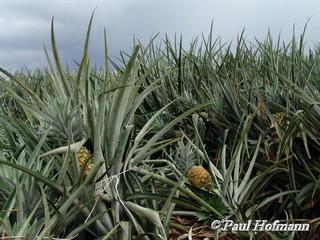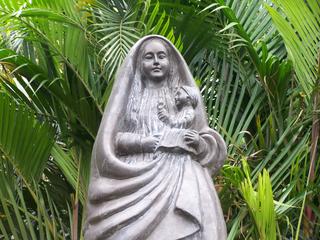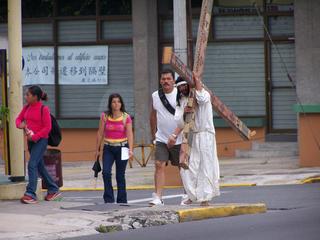Costa Rica: Country and Catholicism

Although Costa Rica is not our final destination, we would like to tell you a little about this small Central American country. Its capital is San José, a city of about a million people, located in what is called the Central Valley. We live in a small barrio (neighborhood) of San José called San Pedro, which is about fifteen minutes by bus from the main square. Costa Rica is the most prosperous of the five Central American countries and is rich in tropical rain forests, coffee plantations, pineapple and banana farms, beaches, and impressive volcanoes. Many Americans come here to live and vacation year round. Many buy retirement homes. (We’ve been told that even Michael Jordan has a mansion on the north-Pacific side of the country).

There are only two seasons in the calendar year here – the dry and rainy seasons (summer and winter). It’s the peak of the rainy season now so it rains almost every afternoon for two or three hours. We always have to carry umbrellas with us wherever we go. The climate is tropical throughout the country and San José, being in the mountains some 3,800 ft, has an ideal temperature of 79 degrees most days. Cleveland, Ohio, where Daniel grew up, is about 580 ft above sea level and was much hotter this past summer than San José. The evenings in San José get down to about 59 degrees. But the sea level and costal areas of Costa Rica are much, much hotter than the capital.
Costa Ricans are a friendly people who are very nationalistic and who love to celebrate the victories of their favorite fútbol (soccer) teams. The majority is Catholic (which is also the official state religion) but there are a growing number of Pentecostals (Assemblies of God). Many holidays here center around Catholic traditions. We have experienced a couple of them in the last four months and it’s served to educate us on the strength of Catholicism that is still in Latin America.

One big holiday that is celebrated on August 2nd is called El Dia de La Virgen de Los Angeles (The Day of the Virgin of the Holy Angels). This day honors Costa Rica’s patron saint, the Virgin Mary. It is said on this day in 1635, Mary appeared the first of three times in the form of an eight inch long, black statue made of rock, in the city of Cartago. From these “appearances” the people built a basilica for her in the city. On August 2nd every year, faithful Catholics from all over the country perform Romerias (walks) to the basilica in her honor or to seek her favor for miracles. Some walk days in advance, mile after mile, to show their devotion. At the entrance of the city people can be seen crawling on their hands and knees in order to make their pilgrimage a sacrfice. Thousands of people participate in this celebration. We saw hundreds passing through San José on their way to Cartago some fifteen miles away. Some even dress like Jesus and carry their home-made crosses.

Catholicism is still very strong in Latin America despite the advances of the Evangelical church. The Virgin Mary is especially important for the Catholic faithful. Mother’s Day, celebrated in May in most countries, is August 15 here (the Assumption) because it is believed Mary bypassed death and ascended to heaven on this day. For whatever reason, many Catholics see Jesus as a condemning Judge but Mary as a soft and tender-hearted mediator between us and the Lord, who also comforts and cares for her people. The Beatles’ song Let It Be is the perfect example of Mary’s place in Catholicism. Needless to say, people here still need to hear the true and clear word of the gospel that they might find the only Mediator between God and man, the man Jesus Christ (1 Tim 2:5). The Bible reminds us that there is salvation in no one else, for there is no other name under heaven that has been given among men by which we might be saved (Acts 4:12). The Word of God comforts us like no other.
